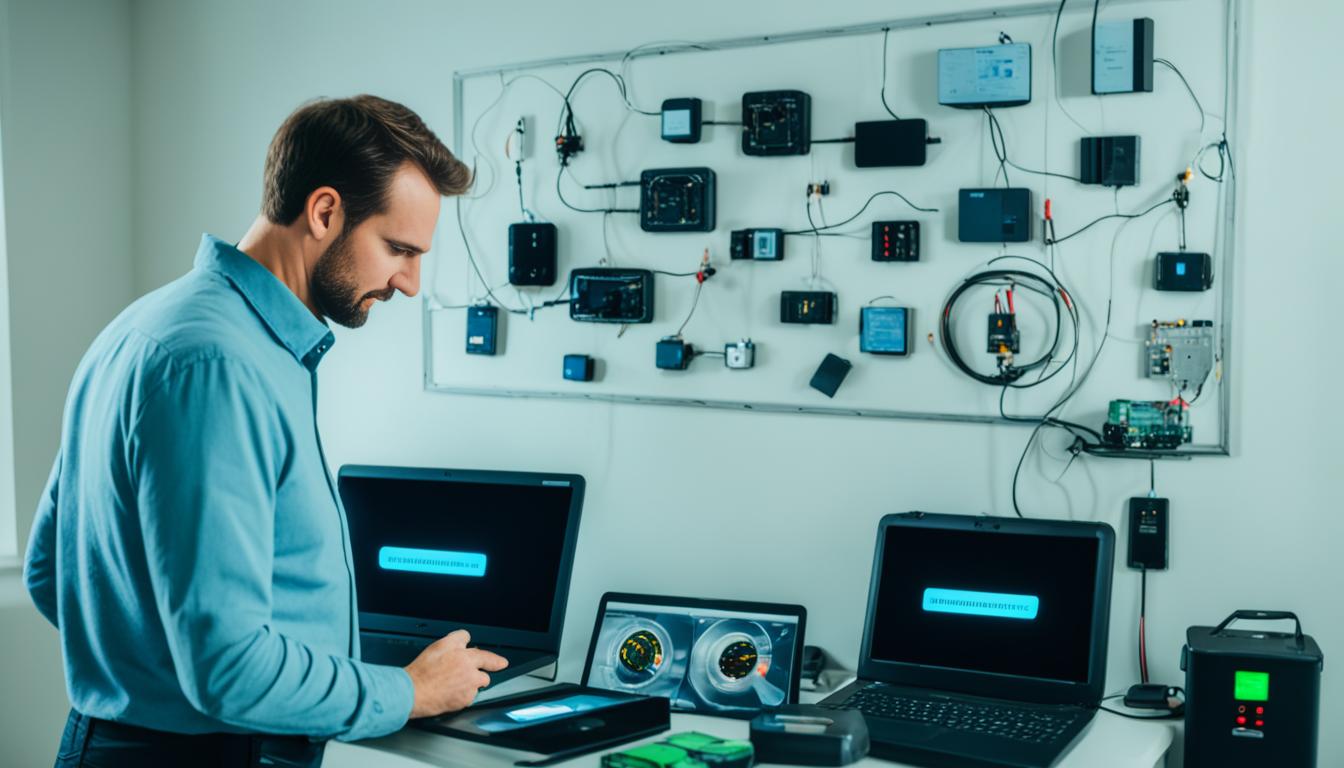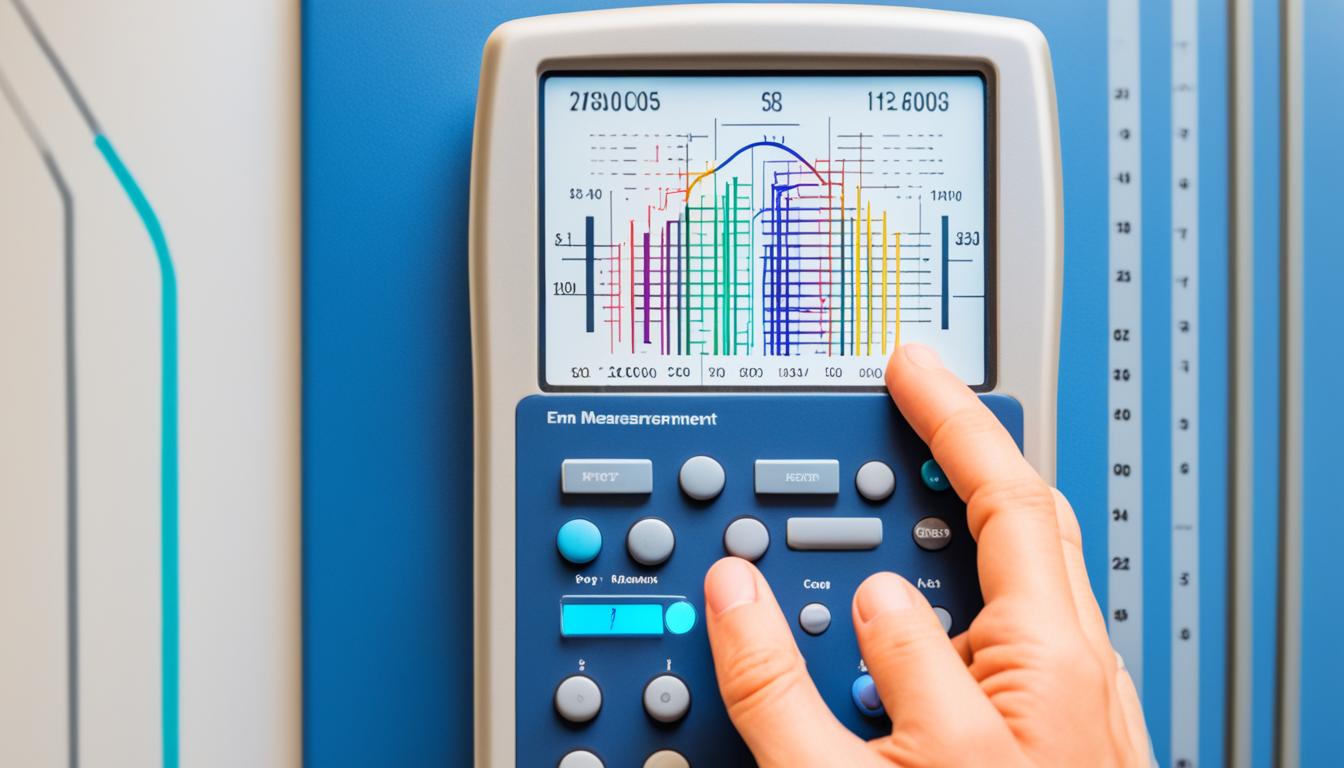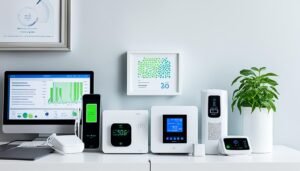Disclosure: This Post Contains Affiliate Links; We earn a commission on purchases.
Electromagnetic Fields or ‘electromagnetic radiation’ is a form of energy discharged from EMF sources. These sources can be found all around us, and it’s important to be aware of them to protect our health. In this article, we will explore the common sources of electromagnetic radiation in your home and how they may impact your well-being.
Key Takeaways:
- Familiarize yourself with common sources of electromagnetic radiation in your home.
- Understanding the potential impact of EMFs on your health is crucial.
- Identify EMF sources using detection methods like an EMF meter.
- Take steps to reduce your overall exposure to EMFs for a healthier living environment.
- Consider using EMF protection products for added safety.
The Effects of EMFs on Your Health
Exposure to electromagnetic fields (EMFs) has raised concerns regarding its potential impact on health. While the industry maintains that EMFs are safe, several studies suggest a possible link between EMF exposure and certain health conditions, including cancer.
A study conducted in Switzerland discovered that individuals exposed to higher levels of EMFs over an extended period had an increased risk of developing specific types of leukemia.
It is important to stay informed about the potential risks associated with EMF exposure. Conducting independent research and consulting reputable sources such as the BioInitiative and the World Health Organization’s International Agency for Research on Cancer (IARC) can provide valuable insights into the health effects of EMFs.
To better understand the potential health risks of EMFs, it is crucial to explore various detection methods and remain knowledgeable about the latest research findings.
EMF Detection Methods
There are several methods available for detecting and measuring EMF levels. These methods provide valuable information about the intensity of EMFs emitted by various sources.
- EMF Meters: These handheld devices help measure the strength and frequency of EMFs in a given area. They are commonly used to identify sources of high EMF radiation, such as electrical appliances, power lines, or wireless devices. EMF meters are particularly useful for evaluating the levels of EMFs in specific locations of your home or workplace.
- EMF Apps: With advancements in technology, smartphone apps have emerged that claim to detect and measure EMF radiation. While their accuracy may vary, these apps can provide a general indication of the EMF levels in your surroundings. However, it is important to remember that dedicated EMF meters offer more reliable and accurate measurements.
- Professional EMF Testing: If you require a comprehensive analysis of your environment’s EMF levels, hiring a professional EMF testing service is recommended. These professionals have specialized equipment and knowledge to assess EMF exposure in detail, providing you with comprehensive reports and recommendations for minimizing exposure.
By utilizing these detection methods, you can gain a better understanding of the EMF levels in your environment and take appropriate measures to mitigate potential health risks.
Next, we will explore effective ways to identify EMF sources in your home and create a safer living environment.
How to Identify EMF Sources in Your Home
Identifying the sources of electromagnetic fields (EMFs) in your home is crucial for understanding and managing your exposure to these potentially harmful emissions. By recognizing and addressing the main EMF sources, you can take proactive measures to minimize your risk and create a safer living environment. Here are some effective methods and tips for identifying EMF sources in your home:
1. Use an EMF Meter or Detector
One of the most reliable ways to identify EMF sources is by using an EMF meter or detector. These handy devices measure the levels of EMFs emitted by various devices and areas in your home. By scanning different areas, appliances, and electronic devices, you can pinpoint areas with high EMF levels. This information will help you prioritize areas for mitigation and reduction.
2. Be Mindful of Common EMF Sources
While an EMF meter can provide accurate measurements, it’s also essential to be aware of the common EMF sources in your home. As mentioned earlier, common sources include wifi, mobile phones and cordless phones, smart devices, smart meters, microwave ovens, electrical wiring, cars, and neighboring wifi networks. By having knowledge of these sources, you can better understand their potential impact on your health and take appropriate steps to limit your exposure.
3. Perform a Visual Inspection
An additional method of identifying EMF sources is through a visual inspection of your home. Look out for electronic devices, appliances, and power lines that could emit EMFs. Pay attention to areas where a cluster of electrical wirings or devices is present. These areas may have higher EMF levels, and you can take measures to reduce your exposure, such as rearranging furniture or relocating appliances.
4. Consult with a Professional
If you’re unsure about the presence of EMF sources in your home or need expert advice, consider consulting with a professional EMF consultant or electrician who specializes in EMF detection and mitigation. They can conduct a comprehensive assessment of your home, provide detailed reports, and suggest suitable measures to minimize your exposure to EMFs.
Identifying the sources of EMFs in your home is the first step toward creating a safer and healthier living environment for you and your family. By utilizing an EMF meter, being mindful of common sources, performing visual inspections, and seeking professional guidance when needed, you can effectively identify and address EMF sources in your home.
Note: The provided image depicts the identification of EMF sources in your home.
Mitigating the Risks of EMF Exposure
To effectively protect yourself from EMF exposure and reduce its potential risks, there are several strategies you can implement. By taking simple steps and making informed choices, you can create a healthier living space with lower levels of EMF exposure.
Reduce Overall EMF Exposure
One of the most effective ways to mitigate the risks of EMF exposure is to reduce your overall exposure. Here are some practical steps you can take:
- Switch off devices that are not in use to minimize EMF emissions.
- Use speakerphone or wired headsets for phone calls to keep your distance from the device.
- Limit the use of wireless devices, such as smartphones and tablets.
- Keep a safe distance from EMF-emitting devices, such as routers and microwaves.

Implementing these measures can significantly reduce your exposure to EMFs and create a safer environment for you and your family.
Invest in EMF Protection Products
There are also specialized products available that can help mitigate the effects of electromagnetic radiation from wireless devices. Companies like Waveguard offer a range of EMF protection solutions for your home, office, and even on-the-go.
“At Waveguard, we are dedicated to providing innovative products that shield you from harmful electromagnetic radiation. Our products are designed to effectively reduce your exposure to EMFs without compromising your daily activities.”
– Waveguard
By incorporating these products into your daily life, you can add an extra layer of protection and reduce the potential risks associated with EMF exposure.
By implementing these strategies to reduce EMF exposure and protect yourself from the potential risks, you can create a safer and healthier living space. Remember, it’s important to stay informed about EMF sources and be proactive in taking steps to minimize your exposure.
Conclusion
Being aware of the common EMF sources in your home is crucial for understanding the potential risks to your health. By identifying these sources, you can take proactive measures to reduce your exposure and protect yourself and your loved ones.
Switching off devices when not in use, using wired headsets instead of wireless ones, and limiting the use of wireless devices are simple yet effective steps you can take to minimize your EMF exposure. Additionally, investing in EMF protection products, such as those offered by reputable brands like Waveguard, can provide an extra layer of defense against electromagnetic radiation.
Remember to stay informed and conduct independent research to understand the latest information and findings on EMF exposure. By prioritizing your well-being and implementing these measures, you can create a safer and healthier living space, reducing the potential risks associated with EMF sources in your home.
Source Links
- https://www.healthandenvironment.org/docs/xaruploads/EMFSourcesAndChoices.pdf
- https://waveguard.com/en/8-most-common-sources-of-emfs-in-your-home/
- https://www.cancer.gov/about-cancer/causes-prevention/risk/radiation/electromagnetic-fields-fact-sheet

Subscribe to Our Newsletter










